Stir-fries are a delicious and versatile dish that is loved by many. In this article, we will uncover the seven common ingredients that make a stir-fry truly flavorful.
Key Takeaways:
- Meat, vegetables, garlic, and ginger are the essential base ingredients for a stir-fry.
- Soy sauce and vinegar enhance the flavor of a stir-fry.
- Cornstarch is used to thicken the sauce and create a velvety texture.
- Additional ingredients like onion, green onions, shallots, herbs, and spices can be added for more flavor.
- Peanut oil, coconut oil, or olive oil are commonly used for stir-frying.
- The cooking process involves preparing and combining the ingredients in a specific order.
- Stir-fries can be served with rice or noodles for a complete meal.
The Essential Base: Meat, Vegetables, Garlic, and Ginger
The foundation of any stir-fry lies in the harmonious blend of meat, vegetables, garlic, and ginger. These ingredients form the essential base that sets the stage for a flavorful and satisfying dish. By carefully selecting high-quality proteins and an array of vibrant vegetables, you can create a stir-fry that tantalizes the taste buds and nourishes the body.
When it comes to meat, options like pork, chicken, beef, or seafood are commonly used in stir-fries. They provide a rich and savory element to the dish. Vegetables, on the other hand, add color, texture, and a variety of nutrients. Whether you prefer crunchy bell peppers, crisp snow peas, or tender broccoli florets, the choice is yours. The key is to choose a combination that complements the protein and ensures a well-balanced meal.
To enhance the flavors of the stir-fry, garlic and ginger are essential. These aromatic ingredients add depth and complexity to the dish. Garlic brings a robust and pungent taste, while ginger adds a subtle warmth and zing. Together, they create a flavorful foundation that permeates every bite.
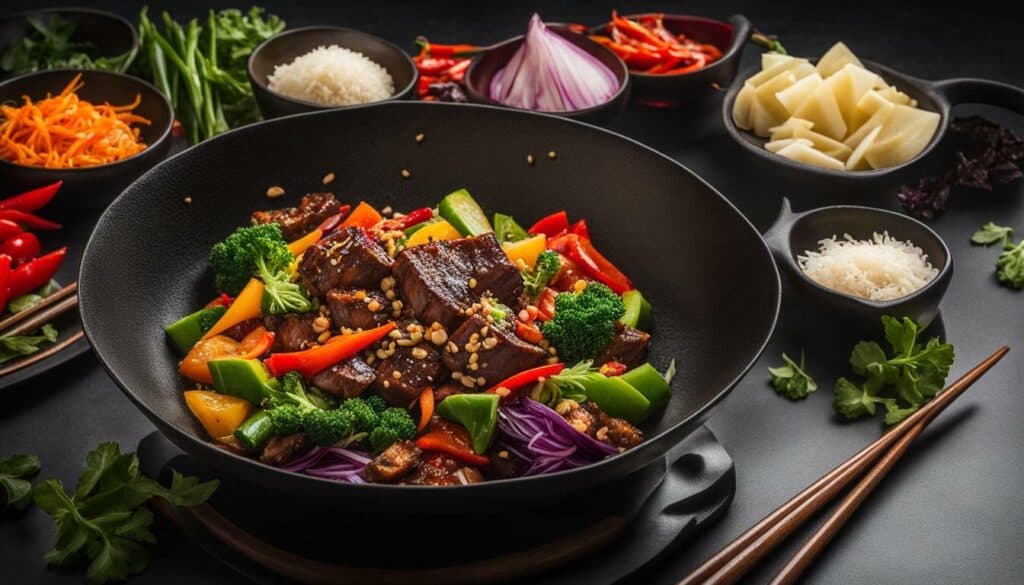
Remember, the success of a stir-fry lies in the preparation. All ingredients should be prepped and ready before you crank up the heat. Mince the garlic, grate the ginger, slice the meat and vegetables, and have the sauce ingredients measured and within reach. This will allow for a smooth and seamless cooking process, ensuring that your stir-fry comes together effortlessly.
Now that we have established the essential base of a stir-fry, let’s move on to explore the other key ingredients that contribute to a delightful and flavorful dish.
Enhancing Flavor: Soy Sauce and Vinegar
For that unmistakable savory and tangy taste, soy sauce and vinegar are indispensable ingredients in a stir-fry. These two powerhouses work together to create a flavorful and well-balanced sauce that brings out the best in every bite.
Soy sauce, made from fermented soybeans and wheat, provides a rich umami flavor that enhances the overall taste of the stir-fry. Its salty and slightly sweet notes bring depth to the dish, while its dark color adds a beautiful caramel hue. Whether you prefer light soy sauce for a milder taste or dark soy sauce for a deeper flavor, soy sauce is the key to a delicious stir-fry.
“Soy sauce adds a depth of flavor to the stir-fry that is hard to replicate. Its umami notes perfectly complement the meat and vegetables, creating a harmonious blend of tastes.” – Chef John
Vinegar, on the other hand, adds a tangy kick that cuts through the richness of the stir-fry. A splash of rice wine vinegar or a drizzle of black vinegar brings brightness to the dish and balances the flavors. The acidity of vinegar also acts as a natural tenderizer, ensuring that each ingredient in the stir-fry is perfectly cooked and infused with flavor.
So next time you whip up a stir-fry, don’t forget to reach for the soy sauce and vinegar. Their combined magic will elevate your dish to new heights of deliciousness.
Table: Common Types of Soy Sauce
| Type | Flavor | Color |
|---|---|---|
| Light Soy Sauce | Mild, salty, and slightly sweet | Light golden |
| Dark Soy Sauce | Rich, deep, and slightly caramelized | Dark brown |
| Low-Sodium Soy Sauce | Milder than regular soy sauce | Similar to light soy sauce |
| Tamari Sauce | Wheat-free alternative, slightly thicker | Similar to light soy sauce |
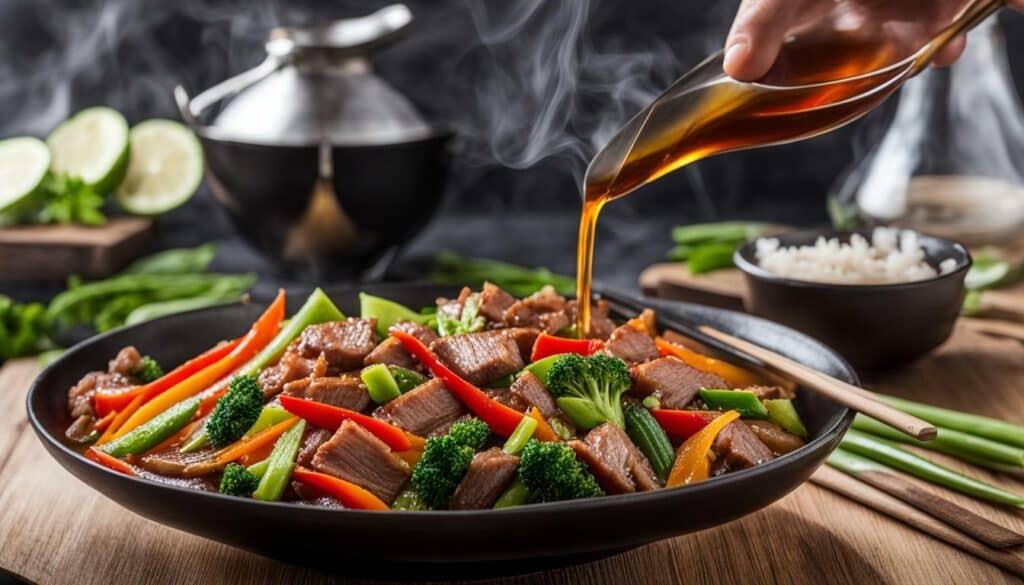
Thickening the Sauce: Cornstarch
To achieve the perfect consistency and texture, cornstarch is often added to the stir-fry sauce. This versatile ingredient acts as a thickening agent, helping to create a velvety, glossy sauce that coats the ingredients in the stir-fry. Whether you prefer a light or thick sauce, cornstarch can be adjusted to suit your personal taste.
When using cornstarch in a stir-fry, it’s important to create a slurry first. This involves combining cornstarch with a small amount of cold water to create a smooth paste. This step ensures that the cornstarch will dissolve evenly in the sauce and prevent any lumps from forming.
“Cornstarch is my go-to for thickening sauces in stir-fries. It gives the sauce a wonderful texture and helps it cling to the ingredients,” says Chef Lisa. “Just make sure to dissolve it in water before adding it to the wok.”
Once the slurry is ready, it can be added to the stir-fry towards the end of the cooking process. This allows the sauce to thicken and coat the ingredients, creating a delicious and flavorful dish. Keep in mind that the sauce will continue to thicken as it cools, so be mindful of how much cornstarch you add.
| Cornstarch Tips: |
|---|
| Start with a small amount of cornstarch and gradually add more if needed. It’s easier to thicken a sauce than to thin it out. |
| If you prefer a lighter sauce, reduce the amount of cornstarch or omit it altogether. You can still enjoy a flavorful stir-fry without the thickening agent. |
| For a gluten-free option, look for cornstarch brands that are certified gluten-free. This ensures that the cornstarch is not cross-contaminated with gluten-containing grains. |
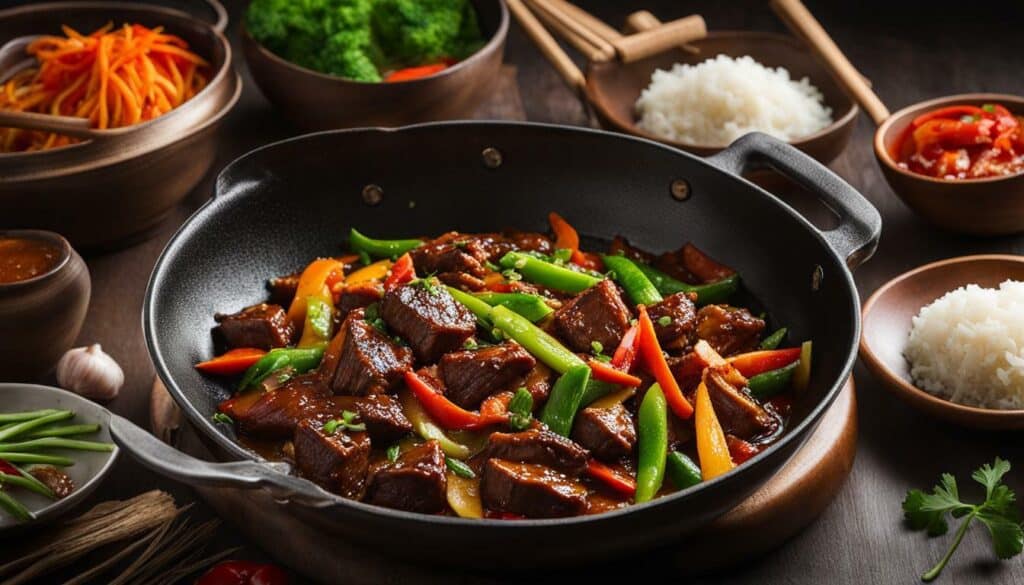
Adding cornstarch to your stir-fry sauce is a simple yet effective way to achieve the desired consistency and texture. Experiment with different amounts to find your preferred thickness, and don’t be afraid to personalize your stir-fry with other seasonings and ingredients to create a unique flavor profile. With cornstarch, you can elevate your stir-fries to new heights of deliciousness!
Flavorful Additions: Onion, Green Onions, Shallots, Herbs, and Spices
Beyond the core ingredients, there are several flavorful additions that can take your stir-fry to the next level. Onion, green onions, shallots, herbs, and spices add depth, aroma, and complexity to your dish, making it truly memorable.
Onion is a staple in many stir-fry recipes, providing a sweet and slightly tangy flavor. It also adds texture and visual appeal to the dish. Whether you prefer white, yellow, or red onion, thinly slicing it and tossing it into the sizzling wok will infuse your stir-fry with a savory taste.
Green onions, also known as scallions, bring a fresh and mild onion flavor to your stir-fry. They can be used as a garnish or added during cooking to impart a subtle, onion-like taste. Chop them into small pieces and sprinkle them on top of your finished stir-fry for a burst of color and flavor.
Shallots are another great addition to stir-fries. They have a milder and sweeter flavor compared to onions, adding a delicate touch to your dish. Finely chop or slice shallots and cook them briefly in the wok before adding other ingredients.
To elevate your stir-fry’s taste profile, consider incorporating herbs like basil or cilantro. These aromatic herbs add a refreshing and fragrant note to your dish. Chop them finely and sprinkle them on top just before serving to maximize their flavor.
Spices can also be used to enhance the taste of your stir-fry. Powdered garlic or ginger can be added during cooking to infuse the dish with a rich and intense flavor. Experiment with other spices like chili flakes or Chinese five-spice powder to create a unique and personalized stir-fry experience.
| Ingredient | Flavor Profile | Usage |
|---|---|---|
| Onion | Sweet, slightly tangy | Thinly sliced, cooked |
| Green onions | Fresh, mild onion | Chopped, garnish or cook |
| Shallots | Milder, sweeter than onions | Finely chopped, cook |
| Herbs (e.g., basil, cilantro) | Refreshing, fragrant | Finely chopped, garnish |
| Spices (e.g., garlic powder, ginger powder) | Intense, aromatic | Added during cooking |
By including these flavorful additions in your stir-fry, you’ll be able to create a dish that not only satisfies your taste buds but also captivates the senses. Experiment with different combinations and quantities to discover your favorite flavor profiles. Get creative and make each stir-fry a unique culinary adventure!
Choosing the Right Oil: Peanut Oil, Coconut Oil, or Olive Oil
The choice of oil plays a crucial role in achieving the perfect stir-fry, and there are a few options to consider. Traditionally, peanut oil has been the go-to choice due to its high smoke point and neutral flavor, which allows the true flavors of the ingredients to shine. It also adds a distinctive nutty aroma to the dish. However, if you have allergies or a preference for other oils, both coconut oil and olive oil can be excellent alternatives for stir-frying.
Coconut oil can add a subtle tropical flavor to your stir-fry dishes, enhancing the overall taste. It provides a light sweetness that pairs well with both meat and vegetables. Additionally, coconut oil contains healthy fats that can benefit heart health.
Olive oil, particularly extra virgin olive oil, is known for its rich and robust flavor. It adds a depth of flavor to stir-fries and is especially delicious when paired with Mediterranean-inspired ingredients such as garlic, basil, or oregano. However, it is important to note that olive oil has a lower smoke point compared to peanut oil and coconut oil, so it may not be ideal for high-heat stir-frying.
| Oil | Smoke Point | Flavor |
|---|---|---|
| Peanut Oil | 450°F (232°C) | Neutral with a nutty aroma |
| Coconut Oil | 350°F (177°C) | Subtle sweetness with a hint of tropical flavor |
| Olive Oil | Medium heat: 325-375°F (163-190°C) | Rich and robust |
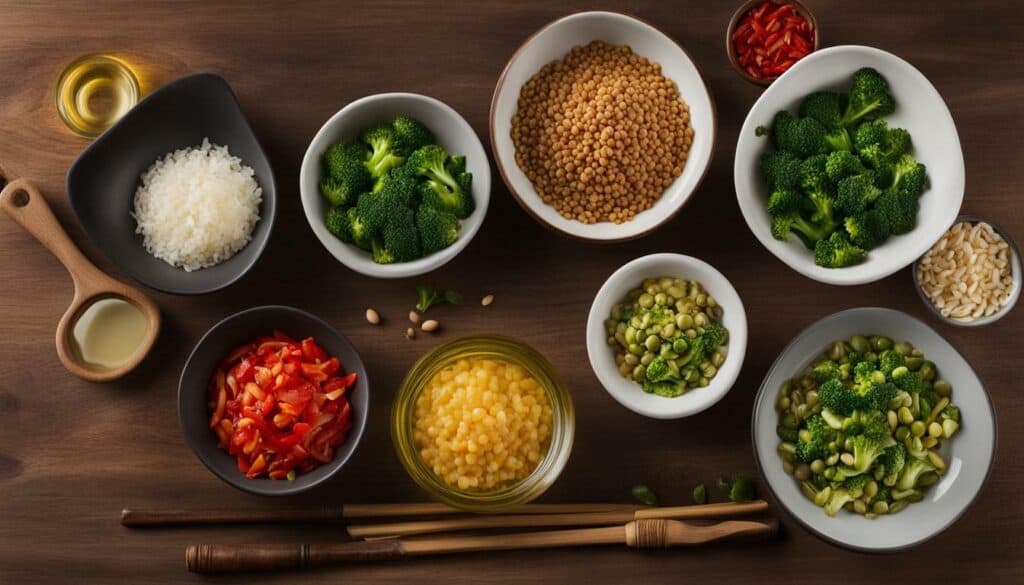
When choosing the right oil for your stir-fry, consider the flavor profile you want to achieve and the cooking temperature required. Peanut oil remains the most popular choice, but coconut oil and olive oil can offer unique flavors and health benefits. Experiment with different oils to discover your favorite and elevate your stir-fry game to new heights!
The Cooking Process: Preparing and Combining the Ingredients
Mastering the cooking process is essential to create a delicious and well-balanced stir-fry. To begin, gather all the ingredients and have them prepared and ready to go before starting the cooking process. This ensures a smooth and efficient cooking experience.
Start by heating your wok or skillet over high heat. Add a tablespoon of oil, preferably peanut oil, and allow it to heat up. Once the oil is hot, add the meat, whether it’s pork, chicken, beef, or seafood. Cook the meat until it is fully done and then remove it from the wok and set it aside.
Next, add another tablespoon of oil to the wok and add the vegetables. Stir-fry the vegetables until they are crisp-tender. At this point, you can add the cooked meat back into the wok along with any additional flavorings like garlic and ginger. These ingredients add depth and aroma to the stir-fry.
Now, it’s time to prepare the sauce. In a separate bowl, combine broth, soy sauce, sugar, and rice wine vinegar. This mixture will be poured over the stir-fry to add flavor and moisture. If you prefer a thicker sauce, add cornstarch to the sauce mixture and stir until it thickens.
Finally, pour the sauce over the stir-fry and toss everything together to ensure that all the ingredients are evenly coated. Continue cooking for a couple more minutes until the sauce has heated through and everything is well combined. Your stir-fry is now ready to be served!
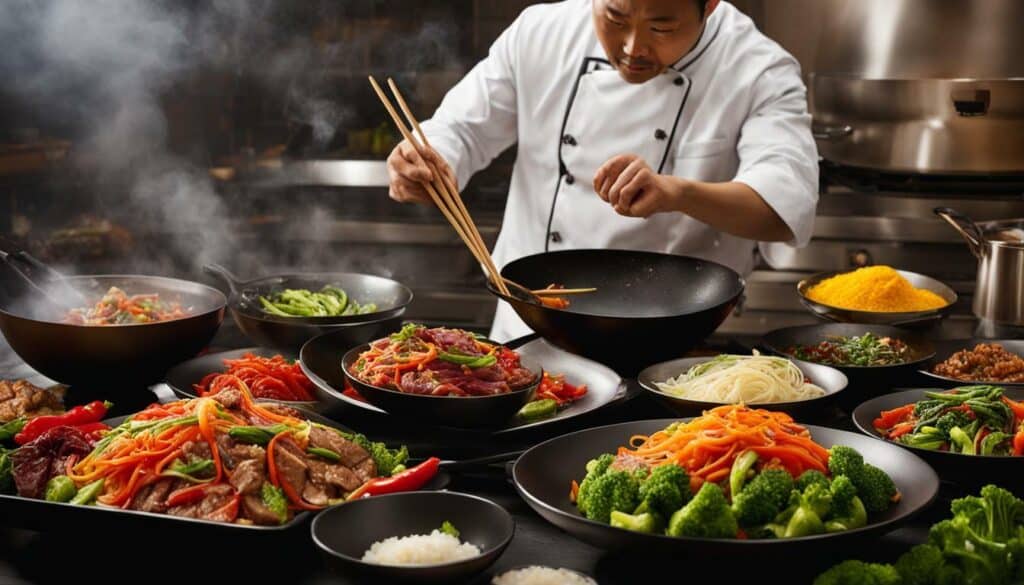
| Meat | Vegetables | Garlic | Ginger | Soy Sauce | Vinegar | Cornstarch |
|---|---|---|---|---|---|---|
| Pork, chicken, beef, seafood | Broccoli, bell peppers, carrots, snap peas | Minced or sliced | Minced or sliced | For umami flavor | For tanginess | For thickening sauce |
Serving Suggestions: Rice or Noodles
To complete your stir-fry meal, serve it with your choice of rice or noodles. These versatile staples pair perfectly with the flavorful stir-fried meat and vegetables, adding texture and substance to the dish. Whether you prefer the fluffy and comforting nature of rice or the chewy and slurp-worthy quality of noodles, both options are sure to satisfy your hunger.
If you’re opting for rice, there are several varieties to choose from. Jasmine rice, a fragrant long-grain rice, is a popular choice for its delicate aroma and slightly sticky texture. Basmati rice, known for its nutty flavor, pairs well with stir-fries that have a lighter and more aromatic profile. Brown rice, a healthier alternative, offers a nuttier taste and chewier texture, making it a hearty complement to any stir-fried dish.
On the other hand, noodles bring a different dimension to stir-fries. Egg noodles, commonly used in Chinese cuisine, have a rich and silky texture that absorbs flavors beautifully. Rice noodles, often found in Thai and Vietnamese dishes, offer a light and delicate bite, allowing the stir-fry ingredients to shine. For a healthier option, you can also choose whole wheat noodles, providing a slightly denser texture and nuttier taste.
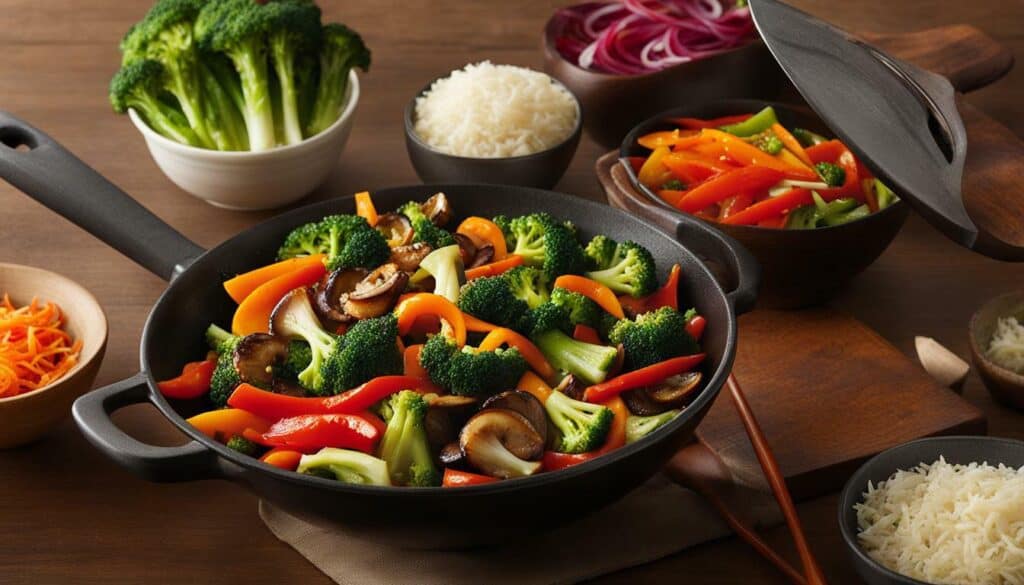
| Rice | Noodles |
|---|---|
| Jasmine Rice | Egg Noodles |
| Basmati Rice | Rice Noodles |
| Brown Rice | Whole Wheat Noodles |
Whichever option you choose, rice or noodles, be sure to cook them according to the package instructions before serving your stir-fry on top. The combination of stir-fried ingredients with a bed of rice or a tangle of noodles creates a satisfying and complete meal that will delight your taste buds.
Tips and Variations for Perfect Stir-fries
Here are some handy tips and creative variations to ensure your stir-fries are always a hit. Whether you’re a seasoned chef or just starting out, these pointers will help you elevate your stir-fry game and create delicious and flavorful dishes every time.
Tips for Perfect Stir-fries:
- Preparation is key: Before you start cooking, make sure to have all your ingredients chopped, sliced, and ready to go. Stir-frying is a fast-paced cooking method, so having everything prepped beforehand will make the process smooth and efficient.
- Use high heat: Stir-frying is all about quick cooking. Make sure your wok or pan is preheated over high heat before adding the ingredients. This will ensure that the meat and vegetables cook quickly while retaining their crunchiness and vibrant color.
- Keep it moving: Stir-frying requires constant stirring and tossing of the ingredients to prevent them from sticking or burning. Use a spatula or wooden spoon to flip and move the ingredients around the pan quickly and evenly.
- Don’t overcrowd the pan: It’s important to stir-fry in small batches, especially if you’re cooking for a large group. Overcrowding the pan will result in steaming rather than stir-frying, which can lead to soggy vegetables and tough meat. Cook in batches for the best results.
- Add the sauce at the right time: The sauce is what brings all the flavors together in a stir-fry. Add it towards the end of the cooking process, once the meat and vegetables are almost cooked. This will prevent the sauce from becoming too watery and ensure it coats the ingredients evenly.
Now that you have these tips in mind, let’s explore some creative variations to spice up your stir-fry repertoire.
Creative Variations for Stir-fries:
- Try different protein options: While meat is commonly used in stir-fries, you can also experiment with tofu, tempeh, or even seitan for a vegetarian or vegan twist. These plant-based proteins soak up the flavors of the sauce beautifully and provide a satisfying texture.
- Go beyond soy sauce: While soy sauce is a staple in stir-fries, don’t be afraid to explore other sauces and condiments. Oyster sauce, hoisin sauce, or black bean sauce can add depth and complexity to your dish. Each sauce brings its own unique flavor profile to the stir-fry.
- Add a kick with spices: If you enjoy spicy flavors, consider adding some chili flakes, sriracha, or Szechuan peppercorns to your stir-fry. These ingredients will bring the heat and create a dish with a punch.
- Play with textures: To add more dimension to your stir-fry, experiment with different textures. Mix crunchy vegetables like bell peppers and water chestnuts with softer ingredients like mushrooms or baby corn. This combination of textures will make each bite interesting and enjoyable.
Remember, stir-frying is all about creativity and personalization. Don’t be afraid to experiment with different ingredients, flavors, and techniques. With practice and these useful tips, you’ll soon be whipping up delicious stir-fries that will impress your family and friends.
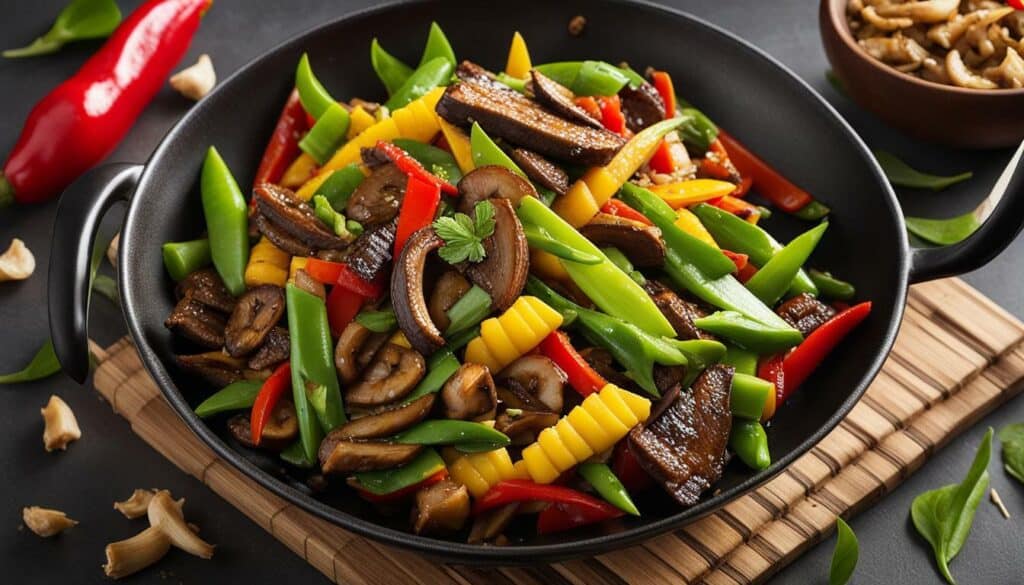
| Common Ingredients |
|---|
| Meat (pork, chicken, beef, seafood) |
| Vegetables |
| Garlic |
| Ginger |
| Soy Sauce |
| Vinegar |
| Cornstarch |
Conclusion
The seven common ingredients in a stir-fry form the backbone of this delectable dish, allowing for endless flavor combinations and culinary creativity. Stir-frying is a versatile cooking technique that brings together a harmonious blend of meat, vegetables, garlic, ginger, soy sauce, vinegar, and cornstarch. These ingredients work in perfect synergy to create a balanced and flavorful stir-fry.
When preparing a stir-fry, it’s important to have all the ingredients prepped and ready to go. Start by cooking the meat until it’s tender and then set it aside. Next, stir-fry the vegetables, adding in the garlic and ginger for an aromatic punch. The meat is then reintroduced into the wok, along with the essence of soy sauce and vinegar, which adds depth and richness to the dish.
To thicken the sauce and give it a luscious texture, cornstarch is added. This not only creates a velvety coating for the meat and vegetables but also helps to bind the flavors together. For an added burst of flavor, ingredients like onion, green onions, shallots, herbs, and spices can be incorporated into the stir-fry.
Traditionally, stir-fries are cooked in peanut oil due to its high smoke point, but alternatives like coconut oil or olive oil can be used depending on personal preference. Once the stir-fry is complete, it is typically served with rice or noodles, which provide a satisfying and substantial base.
With these seven common ingredients as a foundation, the possibilities for creating unique and delicious stir-fry recipes are endless. From classic combinations to adventurous variations, a stir-fry allows you to unleash your culinary imagination and create a meal that is both satisfying and packed with flavor. So, gather your ingredients, fire up the wok, and embark on a stir-frying adventure to delight your taste buds!
FAQ
Q: What are the seven common ingredients in a stir-fry?
A: The seven common ingredients in a stir-fry are meat (pork, chicken, beef, seafood), vegetables, garlic, ginger, soy sauce, vinegar, and cornstarch.
Q: What other ingredients can be added for flavor and variety?
A: Other ingredients that can be added for flavor and variety include onion, green onions, shallots, herbs like basil or cilantro, and spices like powdered garlic or ginger.
Q: What oil is traditionally used for stir-frying?
A: Peanut oil is traditionally used for stir-frying due to its high smoke point, but coconut oil or olive oil can be used as alternatives.
Q: How is the sauce made for a stir-fry?
A: The sauce for a stir-fry is made by combining broth, soy sauce, sugar, and rice wine vinegar. Cornstarch can be added to thicken the sauce if desired.
Q: What is the process for cooking a stir-fry?
A: The process involves cooking the meat first, removing it from the wok, cooking the vegetables, and then adding the meat back in along with the sauce.
Q: What are stir-fries typically served with?
A: Stir-fries are typically served with rice or noodles for a complete meal.
Q: What are some tips and variations for perfect stir-fries?
A: Some tips and variations for perfect stir-fries include customizing the ingredients to personal preferences, experimenting with different sauces and seasonings, and adjusting cooking times for desired levels of crispness.
Are the 3 Main Ingredients in Soap Similar to the Seven Common Ingredients in a Stir-fry?
The three main soap ingredients differ significantly from the seven common ingredients found in a stir-fry. While a stir-fry typically consists of vegetables, meat or tofu, and various seasonings, soap ingredients include fats or oils, an alkali, and water. These components are essential in soap making and play a crucial role in cleansing and moisturizing the skin, unlike the ingredients utilized in a savory stir-fry dish.


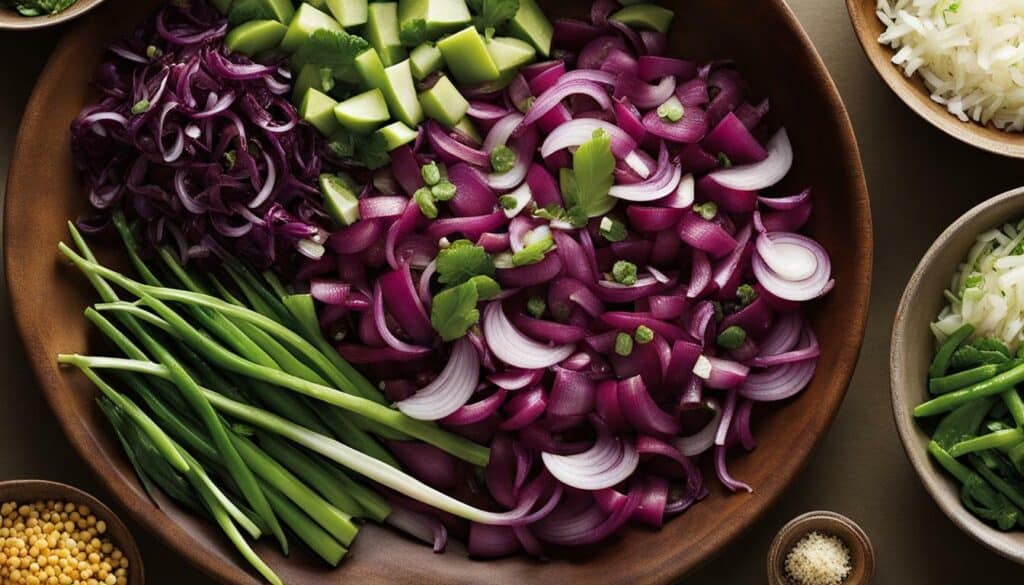



Leave a Reply